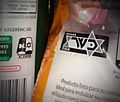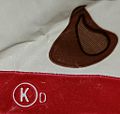Kosher facts for kids
| Part of a series on | |||
|---|---|---|---|
|
|||
| Judaism | |||
| Category | |||
| Jewish religious movements | |||
| Orthodox (Haredi • Hasidic • Modern) | |||
| Conservative • Reform | |||
| Reconstructionist • Renewal • Humanistic | |||
| Jewish philosophy | |||
| Principles of faith • Kabbalah • Messiah • Ethics | |||
| Chosenness • Names of God • Musar | |||
| Religious texts | |||
| Tanakh (Torah • Nevi'im • Ketuvim) | |||
| Ḥumash • Siddur • Piyutim • Zohar | |||
| Rabbinic literature (Talmud • Midrash • Tosefta) | |||
| Religious Law | |||
| Mishneh Torah • Tur | |||
| Shulchan Aruch • Mishnah Berurah | |||
| Kashrut • Tzniut • Tzedakah • Niddah • Noahide laws | |||
| Holy cities | |||
| Jerusalem • Safed • Hebron • Tiberias | |||
| Important figures | |||
| Abraham • Isaac • Jacob | |||
| Moses • Aaron • David • Solomon | |||
| Sarah • Rebecca • Rachel • Leah | |||
| Rabbinic sages | |||
| Jewish life cycle | |||
| Brit • Pidyon haben • Bar/Bat Mitzvah | |||
| Marriage • Bereavement | |||
| Religious roles | |||
| Rabbi • Rebbe • Posek • Hazzan/Cantor | |||
| Dayan • Rosh yeshiva • Mohel • Kohen/Priest | |||
| Religious buildings & institutions | |||
| Synagogue • Beth midrash • Mikveh | |||
| Sukkah • Chevra kadisha | |||
| Holy Temple / Tabernacle | |||
| Jewish education | |||
| Yeshiva • Kollel • Cheder | |||
| Religious articles | |||
| Sefer Torah • Tallit • Tefillin • Tzitzit • Kippah | |||
| Mezuzah • Hanukiah/Menorah • Shofar | |||
| 4 Species • Kittel • Gartel | |||
| Jewish prayers and services | |||
| Shema • Amidah • Aleinu • Kaddish • Minyan | |||
| Birkat Hamazon • Shehecheyanu • Hallel | |||
| Havdalah • Tachanun • Kol Nidre • Selichot | |||
| Judaism & other religions | |||
| Christianity • Islam • Judeo-Christian | |||
| Abrahamic faiths | |||
| Related topics | |||
| Antisemitism • The Holocaust • Israel • Zionism | |||
Kosher is a word from the Hebrew language. It describes the special rules about food that Jewish people follow. These rules come from their holy books. They explain which foods are okay to eat and which are not.
One main rule is that foods like meat and dairy products cannot be eaten together in the same meal. Foods like fish, fruits, and vegetables are called pareve (pronounced "PAR-veh"). They are neutral and can be eaten with either meat or dairy meals. Jewish people who "keep kosher" use different kitchen tools and dishes for meat and dairy foods. They also wait several hours after eating one type of food before eating the other.
Some animal meats are not allowed at all. Animals that are allowed must be killed in a special, careful way by a trained person. Meat that does not follow these rules is called treif (pronounced TRAYf).
Contents
What are the Kosher Food Rules?
Allowed and Forbidden Animals
- Land Animals: Animals that chew their cud (like cows and sheep) and have a split hoof are allowed. This means animals like pigs (which don't chew cud) or camels (which don't have split hooves) are not kosher.
- Meat-Eating Animals: Animals that eat other animals, like carnivores or birds of prey, are not allowed.
- Birds: There is a specific list of birds that are not allowed. For example, ostriches are not kosher.
- Fish: Fish must have fins and scales to be kosher. Fish without scales, like eels, are forbidden. Also, creatures like lobster, shrimp, and shellfish (like mussels) are not kosher.
- Other Animals: No amphibians (like frogs) or reptiles can be eaten. Most insects are also forbidden, though there are a few exceptions like some types of locusts.
- Drinks: Wine must be made in a special way to be kosher.
How Kosher Food is Prepared
- Slaughter: Animals must be killed in a special way by a kosher slaughterer. This person has religious training for the job.
- Sick or Injured Animals: Meat from an animal that died naturally, was killed by another animal, or was sick, cannot be eaten.
- Blood: No blood may be eaten. All blood must be drained from the meat by soaking and salting it. Even eggs with a spot of blood cannot be eaten.
- Factory Foods: Many packaged foods have special symbols on their labels. These symbols, called hechsherim, show that the food has been checked and is kosher.
- Kitchen Tools: A kosher kitchen has separate sets of dishes and utensils. One set is for meat foods, and another set is for dairy foods.
- Sabbath: Food may not be cooked during the Sabbath. This is a holy day in Judaism called Shabbat.
Related pages
Images for kids
-
Kosher airline meal approved by The Johannesburg Beth Din
-
Cloven hooves in goats (upper left), pigs (lower left), and cattle (lower right). Horse hooves (upper right) are not cloven.
-
The label on a bottle of orange juice certifying that it is kosher for Passover
-
A cocoon found among barleycorns in a commercially available bag of barley. Foods such as seeds, nuts and vegetables need to be checked to avoid eating insects.
-
The circled U means a product is certified as kosher by the Orthodox Union (OU). "Pareve" means no ingredients are derived from milk or meat.
-
Kosher labels on salt and sugar packages in Colombia.
-
OK Kosher Certification (circled K) symbol with a dairy designation on a bag of chocolate chips
-
Kosher shop in Warsaw, using the Polish spelling of "kosher"
See also
 In Spanish: Kashrut para niños
In Spanish: Kashrut para niños














